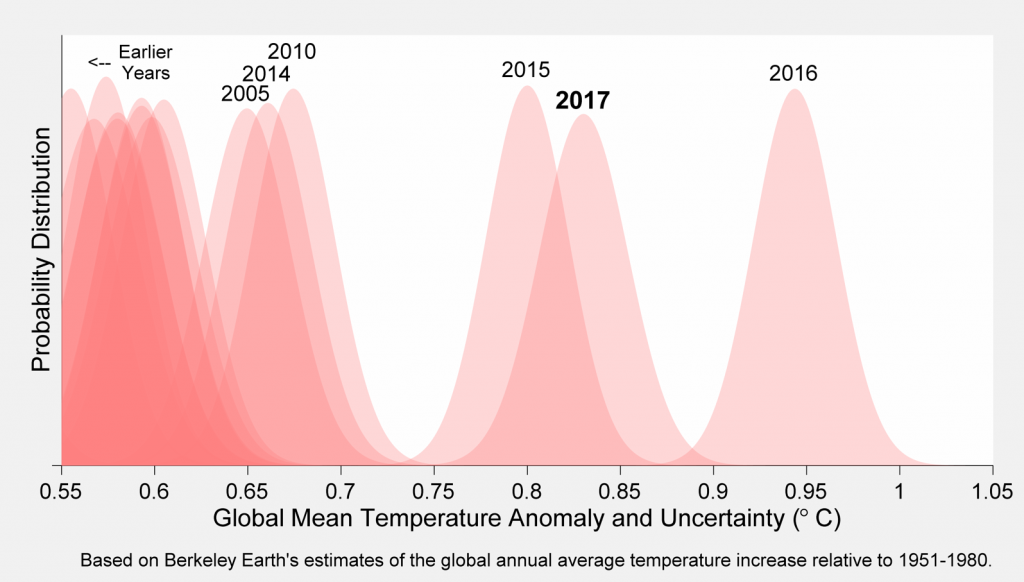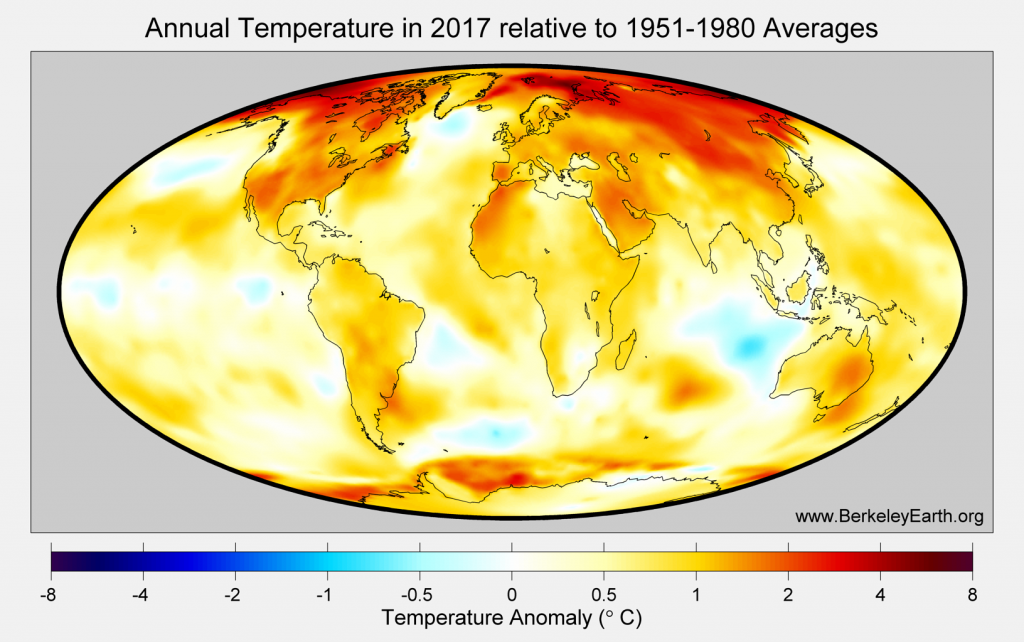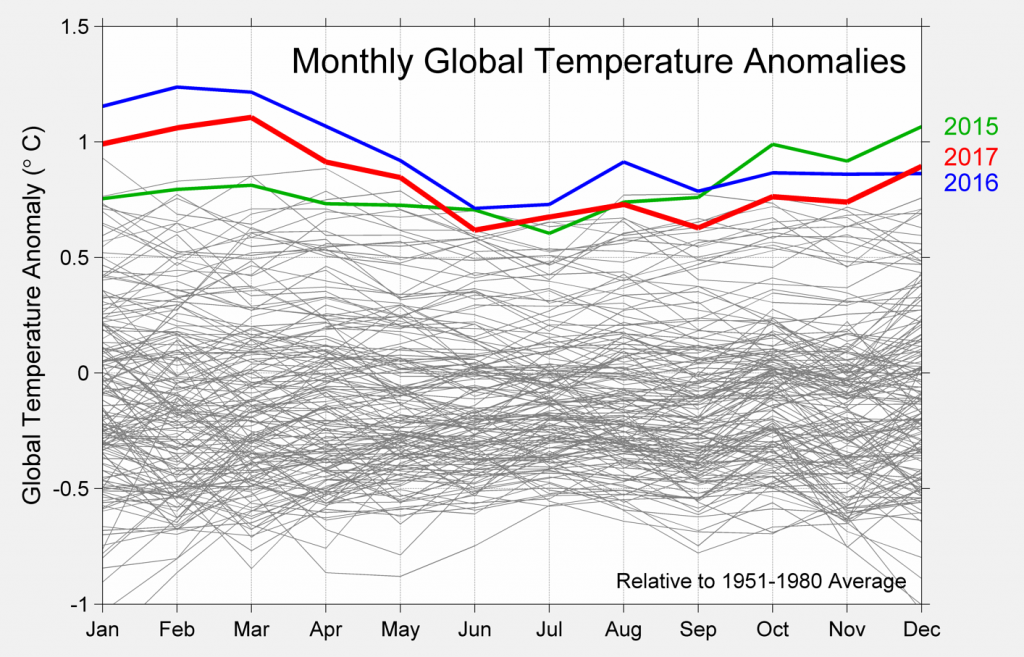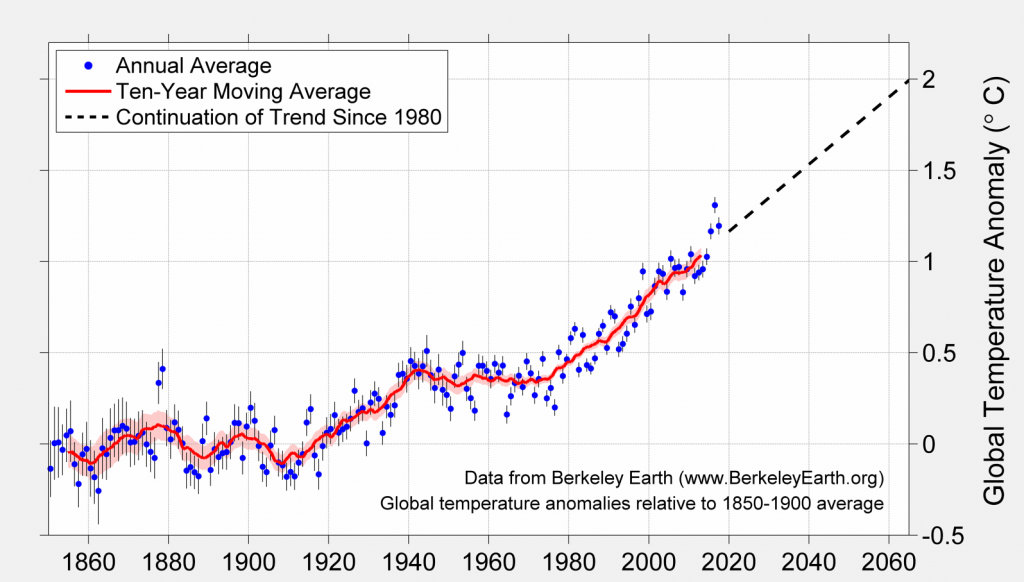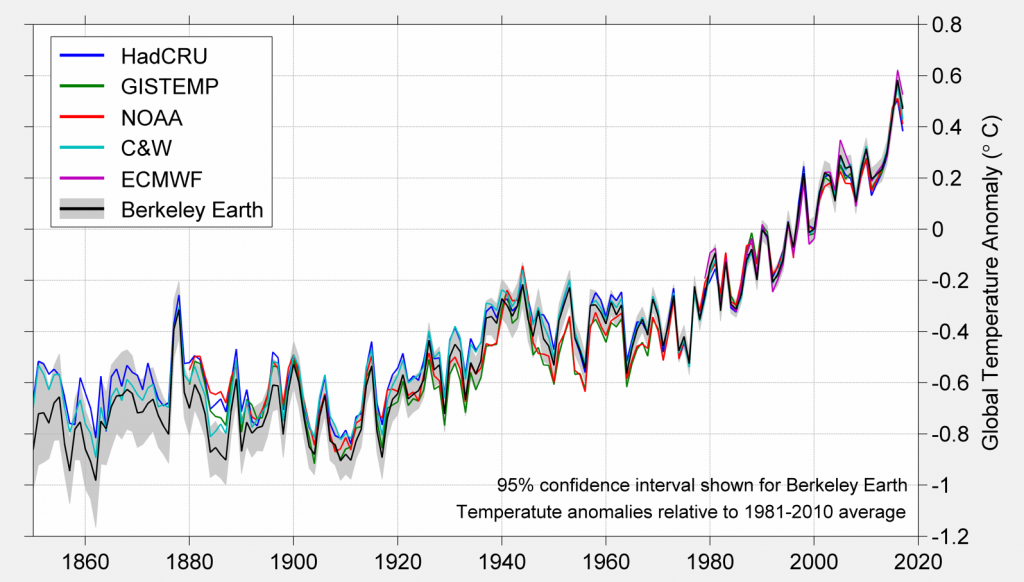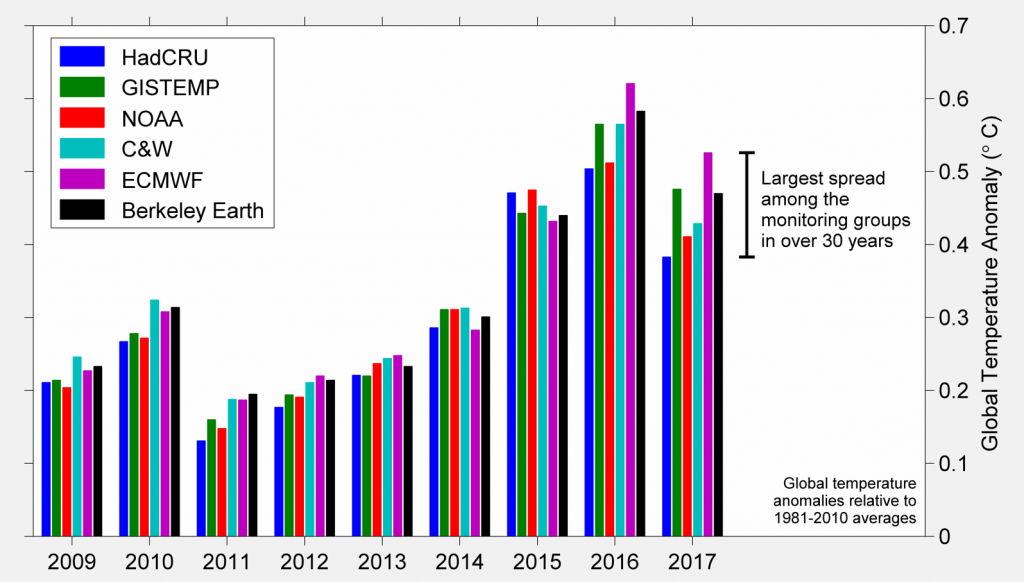Berkeley Earth, a California-based non-profit research organization, has been preparing independent analyses of global mean temperature changes since 2013. The following is our report on global mean temperature during 2017.
We conclude that 2017 was likely the second warmest year on Earth since 1850. Global mean temperature in 2017 was 0.03 °C (0.05 °F) warmer than 2015, but 0.11 °C (0.20 °F) colder than 2016. As a result, 2016 remains the warmest year in the historical observations.
Annual Temperature Anomaly
| Year | Rank | Relative to 1981-2010 Average | Relative to 1951-1980 Average | ||
|---|---|---|---|---|---|
| Anomaly in Degrees Celsius | Anomaly in Degrees Fahrenheit | Anomaly in Degrees Celsius | Anomaly in Degrees Fahrenheit | ||
| 2017 | 2 | 0.47 ± 0.05 | 0.85 ± 0.08 | 0.83 ± 0.05 | 1.49 ± 0.08 |
| 2016 | 1 | 0.58 ± 0.04 | 1.05 ± 0.08 | 0.94 ± 0.04 | 1.70 ± 0.08 |
| 2015 | 3 | 0.44 ± 0.04 | 0.79 ± 0.08 | 0.80 ± 0.04 | 1.44 ± 0.08 |
| 2014 | 5 | 0.30 ± 0.05 | 0.54 ± 0.08 | 0.66 ± 0.05 | 1.19 ± 0.08 |
| 2013 | 9 | 0.23 ± 0.05 | 0.42 ± 0.08 | 0.59 ± 0.05 | 1.07 ± 0.08 |
| 2012 | 13 | 0.21 ± 0.04 | 0.38 ± 0.08 | 0.57 ± 0.04 | 1.03 ± 0.08 |
| 2011 | 15 | 0.20 ± 0.04 | 0.35 ± 0.08 | 0.56 ± 0.04 | 1.00 ± 0.08 |
| 2010 | 4 | 0.31 ± 0.04 | 0.57 ± 0.08 | 0.67 ± 0.04 | 1.21 ± 0.08 |
Uncertainties indicate 95% confidence range.
In the analysis that Berkeley Earth conducts, the uncertainty on the mean temperature for recent years is approximately 0.05 °C (0.09 °F). Since 2016 was warmer than 2017 by 0.11 °C (0.20 °F), more than double the uncertainty, we regard 2016 as unambiguously warmer than 2017.
When comparing 2017 to 2015, the smaller difference is less than the estimated uncertainty. Based on the best estimates for each of these years, and the uncertainties involved, we believe there is roughly an 80% likelihood that 2017 was warmer than 2015. Consequently, it is likely that 2017 was the 2nd warmest year overall. These uncertainties can be understood using the schematic below where each year’s estimate is represented by a distribution reflecting its uncertainty.
In addition to noting that 2016 ranks second overall, we note that 2015, 2016, and 2017 all stand out as exceptionally warm compared to all previous years since 1850.
In part, this reflects the long-term trend towards global warming; however, it also reflects exceptional short-term weather conditions present during this period. Both 2015 and 2016 were warmed by an El Niño event that peaked in Nov/Dec of 2015 and was reported by NOAA as essentially tied for the strongest El Niño ever observed. This exceptional El Niño created temporary weather conditions that would be expected to have boosted global mean temperature in 2015 and 2016. However, 2017 is the warmest year to have occurred in the absence of El Niño conditions.
Temperature Distribution in 2017
The following map shows where and to what degree temperatures in 2017 have increased relative to the average temperature in 1951-1980.
As can be expected from global warming, the temperature increase over the globe is broadly distributed, affecting nearly all land and ocean areas. In 2017, 87% of the Earth’s surface was significantly warmer than the average temperature during 1951-1980, 10% was of a similar temperature, and only 2.5% was significantly colder.
We estimate that 6% of the Earth’s surface registered a local record for warmest year. In 2017, no places on Earth experienced a record cold year. Examining national averages extracted from our global dataset, we estimate that 10 countries set new records for their hottest observed year: Argentina, Djibouti, Kenya, Madagascar, Mauritius, Mexico, Morocco, Portugal, Spain, and Uruguay
On average in 2017, land areas show more than twice as much warming as the ocean. When compared to 1951-1980 averages, the land average has increased 1.24 ± 0.05 °C (2.32 ± 0.09 °F) and the ocean average excluding sea ice regions has increased 0.52 ± 0.07 °C (0.94 ± 0.13 °F). As with the global average, 2017 was the second warmest year on land behind 2016. For the oceans, we find that 2017 was the third warmest year behind 2016 and 2015. The following figure shows land and ocean temperature changes relative to the average from 1850 to 1900. The tendency for land averages to increase more quickly than ocean averages is clearly visible.
As in prior years, 2017 also demonstrated very strong warming over the Arctic that significantly exceeds the Earth’s mean rate of warming. This is consistent with the process known as Arctic amplification. By melting sea ice, warming in the Arctic regions allows more sunlight to be absorbed by the ocean which leads to yet more warming. The resulting feedback allows a rate of warming in the Arctic that is faster than that which occurs in other parts of the world. 2017 was the second warmest year in the Arctic.
Both the tendency for land to warm faster than ocean and the higher rate of warming over the Arctic are features expected based on our understanding of how increases in greenhouse gas concentrations will impact the Earth’s climate.
Lastly, we note that the equatorial Eastern Pacific shows a weak cooling in the annual average map. This is reflective of the move towards La Niña conditions in the latter half of 2017. The weak to moderate La Niña conditions that developed at the end of 2017 are expected to have a modest cooling effect on 2018.
Monthly Temperature Pattern
Examining the pattern of monthly temperature anomalies in 2017, we find that no months in 2017 set a new temperature record. Seven of the twelve months landed in 2nd place, with all but one month being cooler than the corresponding month in 2016. Like 2016, the early months of 2017 stand out as exceptionally warm compared to previous years. In both 2016 and 2017, the warmth early in the year was most prominently expressed as extremely warm temperatures in the Arctic and sub-Arctic land areas. Some of these northern high latitudes experienced monthly averages 10-15 °C (18-27 °F) above normal.
Lastly, we note that inspection of the September to December temperature anomaly maps clearly reveal the developing La Niña conditions as a cold pattern in the Eastern Equatorial Pacific.
Long-Term Trend
Though it is interesting to understand the characteristics of individual exceptional years, the story of global warming is ultimately derived from the long-term evolution of Earth’s climate. The following chart shows a ten-year moving average of the Earth’s surface temperature, plotted relative to the average temperature from 1850-1900.
Since 1980, the overall trend is +0.18 °C/decade (+0.33 °F/decade) and has changed little during this period. By continuing this trend, we can make a rough guess for how near-future climate may develop if the forces driving global warming continue at their present rate.
As shown in the chart, several recent years have had temperatures more than 1 °C (1.8 °F) above the average temperature from 1850-1900. The Paris Agreement on Climate Change aims to keep global temperature rise well below 2 °C (3.6 °F) and encourages parties to strive for warming of no more than 1.5 °C (2.7 °F). At the current rate of progression, the increase in Earth’s long-term average temperature will reach 1.5 °C (2.7 °F) above the 1850-1900 average by 2040 and 2 °C (3.6 °F) will be reached around 2065. The increasing abundance of greenhouse gases in the atmosphere due to human activities is the direct cause of the recent global warming. If the Paris Agreement’s goal of no more than 1.5 °C (2.7 °F) warming is to be reached, significant progress towards reducing greenhouse gas emissions must be made soon.
Comparisons with other groups
Other temperature research groups all agree that the Earth has seen considerable warming since the middle of the 20th century. The following graph shows annual average temperature estimates from Berkeley Earth and 5 other research groups that estimate surface temperature.
All of the major surface temperature groups have also ranked 2017 as either the 2nd or 3rd warmest year.
| Research Groups with Confirmed Results for 2017 | 2017 Rank |
|---|---|
| Berkeley Earth | 2nd (after 2016) |
| NASA Goddard Institute for Space Studies (NASA GISS) | 2nd (after 2016) |
| Copernicus Climate Change Service at the European Centre for Medium-Range Weather Forecasts (ECMWF) | 2nd (after 2016) |
| UK Met Office Hadley Centre & Univ. of East Anglia’s Climatic Research Unit (HadCRU) | 3rd (after 2016 and 2015) |
| National Oceanic and Atmospheric Administration (NOAA) | 3rd (after 2016 and 2015) |
| Kevin Cowtan and Robert Way (C&W) | 3rd (after 2016 and 2015) |
The slight disagreement in the ranking reflects both the uncertainty in these estimations and the differences in how various research programs look at the Earth. For example, the NOAA and HadCRU efforts omit most of the polar regions when estimating mean temperature changes. As a result, some groups are unable to capture the strong Arctic warming observed by Berkeley Earth, ECWMF, and others.
It should be noted that the amount of disagreement amongst groups is unusually large in 2017, with the observed spread larger than for any year in over three decades. In 2016, the range of disagreement was also unusually large. Last year, an analysis conducted by the UK Met Office demonstrated that the disagreement amongst groups arose primarily from the differences in spatial coverage, especially the inclusion or exclusion of polar regions. As the Arctic continues to warm faster than the majority of the Earth, correctly capturing changes in the Arctic may become increasingly important in order to provide a complete picture of climate change.
Methodology
In reconstructing the changes in global mean temperature since 1850, Berkeley Earth has examined 16 million monthly average temperature observations from 43,000 weather stations. Of these 20,000 stations and 220,000 monthly averages are available for 2017. This collection of weather station data greatly exceeds the 5,000-10,000 stations used by other groups. By bringing in a greater volume of data, Berkeley Earth is able to significantly reduce our uncertainties.
The weather station data is combined with sea surface temperature data from the UK Met Office’s Hadley Centre (HadSST). This ocean data is based on 355 million measurements collected by ships and buoys, including 12 million observations obtained in 2017. We reprocess and interpolate the HadSST data to provide a more complete picture of the oceans. After combining the ocean data with our land data, we arrive at a global average picture of climate change since 1850.
Uncertainties arise primarily from the incomplete spatial coverage of historical weather observations, from noise in measurement devices, and from biases introduced due to systematic changes in measurement technologies and methods. The total uncertainty is much less than the long-term changes in climate during the last 150 years.
This report is based on such weather observations as had been recorded into global archives as of early January 2018. It is common for additional observations to be added to archives after some delay. Consequently, temperature analysis calculations can be subject to revisions as new data becomes available. Such revisions are typically quite small and are considered unlikely to alter the qualitative conclusions presented in this report.


